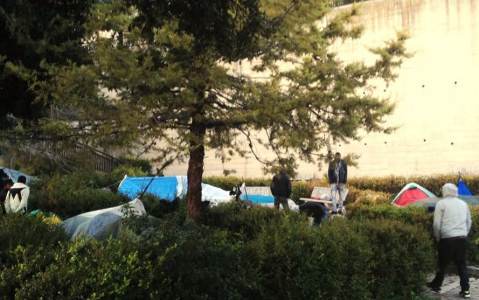New Landing Procedures or Simply Chaos? The Example of a “Delayed Landing” at Messina
“In aleis strenua – in pugna invicta”: “Resolute in venture, invincible in battle.” This is the motto of the Italian navy’s imposing vessel the Virginio Fasan (F591), the unusually long stop-over of which at the port of Messina drew the curiosity of passers-by. It raised doubts and some confusion among the local activists, readily expressed in the press release from the Communist Refoundation Party (PRC) of Messina, who in the end “allowed” us to arrive in time to help with the last day of what had become one of the longest and most exhausting landing operations in recent history. The last group of migrants, around 150 of the total 1,159, were allowed to leave the ship by 9pm on Thursday 1st September, that is, 48 hours after the disembarking began in the late afternoon of August 30th.
What was the reason for this inconceivable and unacceptable delay? Was it a planned choice or a necessity? There are many theories, but at the moment no official response. From the accounts gathered on Thursday afternoon – taken while observing from nearby the slow journey of each migrant disembarking from the ship – there emerged some relevant factors:
“The landing operations began in the late afternoon of Tuesday August 30th […] initially the procedures seemed to be going ahead as usual. Around thirty people had disembarked when, all of a sudden, some officers from the Ministry of Health who were present at the dock gave the order for only the women and children to disembark. After some moments of rushing around, only the women and minors were indeed disembarked […] In total there were around 130 people who came off the ship, including 70 ‘vulnerable persons’ as well as the women and children.”
Tuesday 30th August – photo identification of the first groups of women on the quayside
This is what Marta Bellingreri reported after she had just arrived at the port, who was also present Tuesday evening with a team from the BBC. While we will try to reconstruct what had come to pass in the preceding days, we ought note from the start the total absence of international organisations such as IOM* and UNHCR*, who were very likely forced to choose between the large number of landings occurring across the Sicilian ports.
Later we inquired as to the reasons for the methods of disembarking and one of the police officers on the quay, noting the similarities between what we were seeing unfold and the practices which had been enacted the previous day (and night) at the landing at Palermo.
The first response was “Messina doesn’t have a Hotspot.” After a brief chat we soon arrived at a second and significant fact: “The centres are full, both in the city itself and beyond. To be quite honest, while we were receiving more than 1,100 people off this ship, Trapani sent, overland, 200 migrants to Pala Nebiolo.”
Just as honestly, and without any irony, we emphasises the comparison with the landing at Palermo, and our concerns as to whether we were, in fact, enacting the so-called ‘floating Hotspots’? Were we not, in fact, trying – far from spying eyes – trying to divide up the migrants on the basis of their nationality for the busy work of deporting people to those countries with whom we have proudly signed agreements for readmission? And finally, while we understand the organisational difficulties – given the number of simultaneous landing operations, almost all of which directed to Sicilian ports – how can one really think to force people who have just been through such an exhausting voyage to wait 48 hours on board a ship docked at port, and then another 4 hours on a coach parked in the sun?
The questions and fears expressed meant that, entirely understandably, the response from on high regarding the correct and transparent nature of the police operation was simply that “there is nothing to hide”. There was no comment regarding the visible distress caused to the migrants, but rather a resigned concurrence: the expressions on their faces communicated much more than any words. On the matter of repatriations, however, there was a generic response: “That only happens for North African countries.”
Regarding the last questions we raised, which related more concretely to the papers we saw in the hands of each queuing migrant, the policeman confirmed that he did not know the exact nature of the content, and that they could indeed be what we call notification papers. To the following question regarding the possibility that what was declared in these documents could relate to decretals of deferred rejection according to Article 10.2, a very clear cut response was given: “Absolutely not, they don’t do that anymore.”
Beyond this, it is interesting to note that the slow, drawn out waiting times allowed us to observe the journey consigned for each individual, and attempt to also understand some of the unseen routes. The first of these corresponded to the first necessary stage: a huge blue tent in which, as it became clear afterwards, staff from the Immigration Office distinguished between adults and minors. The feeling however, given the time spent by everyone within the tent and the coming and going of police officers, was that this also functioned as some kind of pre-identification procedure. Once they had left the tent, the migrants were allowed to use the portaloos – 12 in total – which had been brought to the quayside on the evening of August 30th following protests – some of which were quite uplifting, according to Marta Bellingreri – from the ship’s crew and captain who were infuriated by the stench occurring from the migrant’s being forced to make do with using the sea for their physical needs, right next to the vessel itself. The following stage consisted in the photo-identification, undertaken in the open air and thus entirely visible. Along the journey they were also taken to the Red Cross tent which handed out food, along with staff from Misericordie, and those who were not in good health conditions were then consigned to medical care in two tents set aside. Over the afternoon we saw ambulances intervene three times, without forgetting that the previous night there had already been at least three other interventions, including an urgent response for a man suffering an epileptic seizure.
A water tanker was parked next to the tent for the distribution of food and water, so that people could refresh themselves and kill some time. A last queue was reserved for the final stage. Beneath two gazebos belonging to the Prefecture of Messina, three mediators (two women and one man) and a worker from the Amal centre (as was written across her t-shirt) waited for the migrants who arrived with a paper notice in hand, the content of which we did not observe, and who were checked and assisted by other staff who were probably plain-clothes police officers. After a small interview (we heard questions about people’s general details many times over) the migrants signed the notices originally in their possession and handed them to the staff who divided them up into piles kept in order, as best as they could be, on a table next to them. At this point the queue was divided up – and only now did we understand the laughter with which every now and again someone shouted “1998? 2000?” – those who had been deemed minors and were to be accommodated within a green tent behind the mobile office, while everyone else was to be taken to the buses organised either by Calamunci (a private business) or some normal public buses. For the adults, the final stage was the centre at Pala Nebiolo where, within a room transformed into an office run by the police station, they would finish the identification procedures.


Before leaving the port, we had the chance to meet with Mr. Zaccone, the head of Messina city council’s department for social policy. We asked him where the minors would end up, who had already waited at least 5 hours in the green tent – and without forgetting of course the 48 hours on board the ship. In the time period of our brief chat the number of minors passed from just over 20 to a total of 23. “There isn’t any space left in Messina, the centres are all overcrowded. We’re waiting on the Prefecture. The minors who were disembarked in the first two days have been taken into structures in the province: 78 at the former barracks of Gasparro, 5 to the community managed by the Santa Maria della Strata cooperative in Giampilieri and 4 to Fondachelli Fantina.” Given the opportunity of having Mr. Zaccone’s attention, we emphasised the crisis faced by the reception system, above all for the protection of unaccompanied foreign minors in the region. In relation to Messina, we underlined the inadequacy of the former barracks both in terms of the conditions of reception and in relation to the recent change, since June, of the centre into a “new” kind of centre without legal definition, a kind of centre of first reception reserved exclusively for unaccompanied foreign minors. Mr. Zaccone diplomatically shared our concern, noting however that the city council is not responsible for the former barracks at Gasparro, but rather the Prefecture. We nodded. It was indeed for the very next day that we had, in the middle of August, made a request to the Prefecture of Messina for access to the “first reception” centre, without having received any reply.
We left the port, perplexed and with a bitter taste. We await the appointment of the new Prefect on September 5th, in the hope of obtaining some kind of response to our request for access, and above all to understand the reasons for these new methods applied at the disembarking. Smiling, we gave a final and determined nod to a young boy who had been standing for hours at the entrance to the green tent. We mouthed “good luck”. He’ll surely need it.
Elio Tozzi
Borderline Sicilia
Project “OpenEurope” – Oxfam Italia, Diaconia Valdese, Borderline Sicilia Onlus
*IOM: International Organization for Migration
*UNHCR: UN Refugee agency
Translation: Richard Braude




